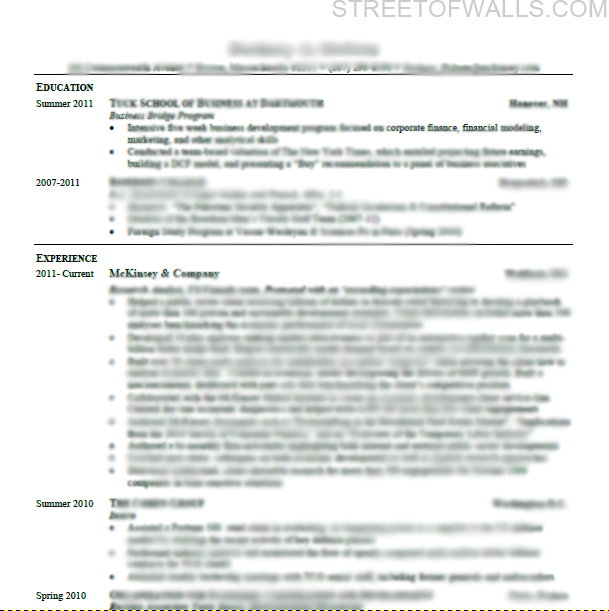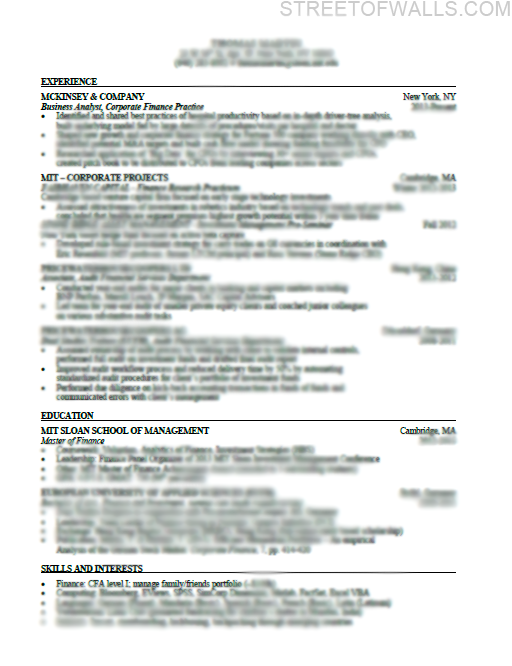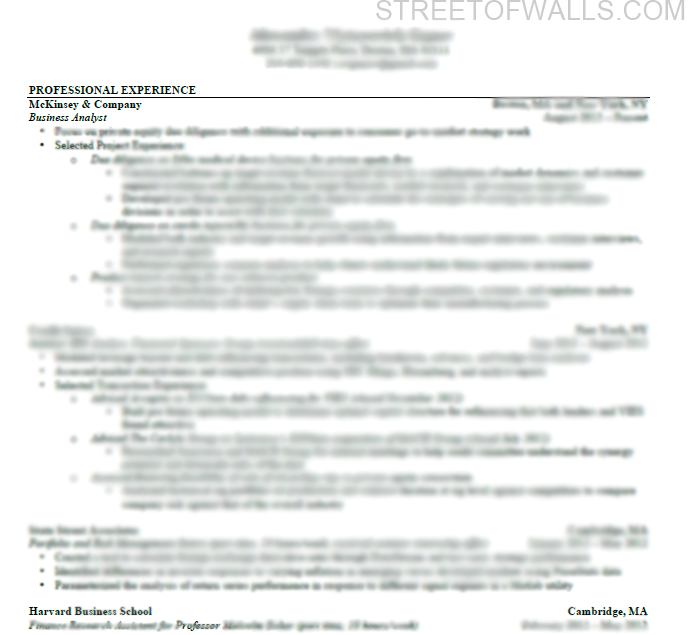Suppose you apply for Consulting jobs online, or through your school’s on-campus recruiting center, with a cover letter and a resume. What happens next? Firms have a resume review session, wherein a team of fairly junior Consultants (usually 1-2 years out of school, and often from your school) read and grade each resume until the thousands of resumes end up in a shortlist to be interviewed.
In this chapter, we will provide key insights and tips for assembling your resume and cover letter to help ensure that your resume makes the shortlist—in other words, we hope to maximize your chances of receiving an interview.
Consulting Resume
Consultants spend approximately 45 seconds reviewing each resume and rarely even look at the cover letter during this period. Always keep that in mind—if it’s not on the resume, most Consultants who are evaluating your application for the job will not see it. We cannot stress this enough. Furthermore, you have a limited amount of time to connect with the Consultants reviewing your resume and communicate to them why you deserve an interview. This means that your resume has to be:
- Punchy
- Articulate
- Results-oriented and
- Extremely well formatted.
The goal of the cover letter should be to augment what is on the resume and explain why you are eager to work for the firm you are applying to. We will discuss cover letters in-depth in the next section of this chapter.
So what should be the core of your resume? For students graduating from an Undergraduate or Graduate program, the priorities are:
- Academic credentials. Good grades are very important in Consulting; mediocre grades can be overcome with interesting work and other experience, but in Consulting, this is an uphill battle.
- Work experience and other interesting experiences. Whether it be a major work experience or a major accomplishment, it is important for the reviewing Consultants to know what you’ve been exposed to and what you’ve accomplished up to this point in your life.
If you are applying as a hire from Industry, simply reverse these two—in other words, work experience comes first, and then academic credentials.
Resume Formatting
If you are just about to start preparing your resume, we highly recommend that you review the following example resumes we have found. Not all of them are from Consulting, but all of them could be used as a basis for properly formatting your Consulting resume:
Consulting firms are not as rigorous as investment banks about the precise formatting of an appropriate resume for individuals applying for junior positions—there is some room for leeway. However, regardless of the exact formatting, you want the resume to look professional, clean, and sharp. It should be easy to read, with only one font used and a consistent font size used (though your name at the top can be a little bit larger, as long as it looks appropriate).
Resume Sections
Regardless of the formatting template you use, an appropriate resume will have the following sections:
- Personal Information Header: Key personal information, including name, address, telephone number, and email address. (Note: be sure that the email address you use has your name in it! Funny or informal email addresses, such as supercooldude35@gmail.com, come across as unprofessional).
- Education: Include your GPA, course details and also any relevant extracurricular activities. Published papers, work with professors, etc. show motivation, ambition and also that a reputable person chose to work with you. If you have high-quality standardized test scores, include those as well. Note that this section would come after Work/Professional Experience for Industry hires.
- Work/Professional Experience: Include all relevant work experience—even something that may not seem like a direct fit, such as being a teaching assistant. The goal here is to show your variety of experiences, and demonstrate that you’re talented and that you’ve taken on challenging work in the past. However, do not include irrelevant work experiences such as working at the university bar, being a cashier or stock boy, etc.
- Other Experience/Skills: This section differs widely across candidates, but is an area in which you can highlight skills and accomplishments that could be useful as a Consultant, such as particular language skills, technical skills, or even volunteer experiences in which you worked with a team. Additionally, this is a chance to show off things you’ve accomplished that demonstrate your talent—awards you’ve won, competitions you’ve been a part of, etc. In short, this is a place to list things that demonstrate your uniqueness and/or capabilities.
- Personal Interests: Interests listed can highlight your personality and breadth of interests, and can often prompt interesting conversations with an interviewer. Remember, interviewers want to hire interesting people. Do not make up any interests, as there’s a good chance you’ll face an interviewer who is knowledgeable in an interest area that you have listed. Also note that as you get older and gain more work experience, this section becomes less relevant.
Remember, your resume is a marketing document. It is a single page on which you get to market yourself. You want to put the best possible version of yourself forward throughout the interview process, and that best possible version of yourself should be crystallized in this one-page document. Do not be afraid to spend a lot of time on it—reviewing it meticulously, revising and improving it, and asking friends and colleagues for help. In particular, it is very helpful to ask for a resume review from friends you know at the firms you are applying to, or friends who are also applying to similar firms.
Additional Tips
- Use bullet points rather than paragraph text. It makes it much easier for the reviewing Consultants to scan through the resume and glean important information quickly.
- For Undergraduates and Graduates, the resume should fit comfortably on 1 page using normal size font (10-12) and normal margins. (Industry hires may have longer resumes, especially if they have worked in Consulting before, because they may wish to enumerate details of projects completed and skills gained.) Keep descriptions short, and don’t worry about providing a ton of detail—if the interviewers are interested in a topic you’ve written on the resume, they can ask more about it in the interview. Keep it punchy!
- Use bold and underline formatting to highlight key points, firm names, school names, etc. Be consistent throughout the document.
- As we mentioned, use the same font and a consistent font size throughout (with your name at the top a possible exception).
- Avoid fancy design of any kind, and do not use any colors other than white background and black text.
- Avoid listing an “Objective” section. Anyone reading your resume will naturally assume that your objective is to secure a job offer with his or her firm, so the “Objective” section is redundant, wasted space.
- This may sound silly, but make sure your interests are interesting. Remember, Consultants are deciding whether they want to work with you in addition to seeing whether you meet the academic and experience criteria. Bland interests such as “reading” and “cooking” are less interesting than “reading vintage comic books” or “taking advanced French cooking courses.”
- If you have one or two major accomplishments (major award, incredible work experience, incredible academics), ensure that these things stand out. If they are in a list, list them near the top, and at least consider making them bold and/or underlined.
- Keep language simple and do not use complex or technical language if it can possibly be avoided.
- Be specific and quantify results where possible. But again, be punchy. When in doubt, choose brevity over detail in specifying your results and achievements.
- Use active voice, Include key Consulting skills subtly in your experience through your choice of descriptive verbs (words/phrases such as analyzed, researched, implemented, managed, evaluated, examined, assessed, quantified, reviewed, surveyed, facilitated, designed, launched, etc.).
- Do not devote more than one line to your high school experience, if at all.
- Submit the resume in PDF format. It looks more professional than Microsoft Word, and there is much less of a chance that the resume will appear to be formatted incorrectly due to subtle differences in the configuration of Word on the recipient’s computer.
- Never be dishonest in any way on your resume. It’s a terrible idea to be dishonest in general, throughout your career—and if anyone uncovers your lie, you will not get the job. In fact, if it is discovered that you lied on your resume when applying, you might get fired after starting the job!
- Proofread, proofread, proofread! Make sure your completed resume has zero mistakes: no typos, no grammatical errors, no spelling mistakes, and no formatting/alignment errors. Then, slowly, re-read it again, very carefully, just to be sure. Few things look worse on a resume than a typo—especially for a Consultant whose job it is to be detail oriented!
To give you a better idea of what your final product should look like, we have procured the following actual Consultant resumes from top firms to show you. We have only obscured the names and most details for privacy reasons:
Consulting Cover Letter
With your resume done, it’s time to turn to your Consulting cover letter. The cover letter is less important than your resume and, given the speed with which your entire submission will be reviewed by Consultants at the firm you’re applying to, the cover letter will often not even be read by anyone. However, cover letters will be read at some places, so it’s important to do them right.
Cover letters themselves will rarely get you an interview. However, they can certainly prevent you from getting an interview, if any egregious mistakes are made in them. So for each cover letter you write, be sure to review it thoroughly to make sure there are no errors in the letter.
Cover Letter Sections
We recommend that you review sample cover letters to get a sense for writing an effective Consulting-focused cover letter. Wikihow provides a few reasonable samples to get you started.
The standard Consulting cover letter structure is as follows:
- Opening with what position you are applying for. Introduce yourself as a strong candidate for this position and mention any consultant at the firm you know/have networked with during the recruiting process, or something else about the firm that led you to apply.
- Mention your education and relevant experience (work and/or other). Include relevant current studies and mention the strength of your academic performance. Mention prior work experience only to the extent that it offers the reader a good sense of why you’re an excellent candidate for the job you’re applying for.
- Discuss your motivation and interest in the position and the firm. Articulate why you want to be a Management Consultant and what skills you have that would make you a strong Management Consultant. Try very hard to touch on something about the firm specifically.
- If applicable, mention any other relevant standout point or accomplishment. This could be in the previous work experience section or in the closing sentences. But if there is something special to mention, be sure to get it in.
- Write the closing. Keep it short and to the point, and offer to provide any additional information they may request. If you’re stuck on what to write here, simply reiterate your interest in the position and the firm.
Writing a good cover letter is pretty much that simple. But here are some additional tips to consider:
Additional Tips
- Keep the cover letter succinct and articulate (use size 12 font and much less than the full page—2/3 of the page at the absolute maximum).
- Specifically mention the exact title of the role you are applying for (be sure to get it right).
- Specifically mention the names of the people that you have networked with during the process–it proves that you were at the firm’s events and took time to speak with some of the consultants from that firm. This reinforces that you are indeed interested in the company.
- A note on this: if mentioning consultants at the firm you have met, be sure that you have actually met them. Simply being in attendance when a Consultant presented to you as a group of students is not good enough. Often, a resume screener will ask that person about you.
- Use bold and underline to highlight key points, but don’t overdo it. One or two items highlighted in the letter is about as far as you should go.
- If you have one or two major accomplishments (major award, incredible work experience, incredible academics) – ensure that these things are mentioned in your cover letter, just like in your resume.
- As with the resume, use active voice, include key consulting skills subtly in your experience through your choice of descriptive verbs (words/phrases such as analyzed, researched, implemented, managed, evaluated, examined, assessed, quantified, reviewed, surveyed, facilitated, designed, launched, etc.).
- Always write the cover letter in the first person. This may seem silly to mention, but believe it or not, I have reviewed cover letters that did not include the word “I” in them. Anywhere!
- As with the resume, submit the letter in PDF format. It looks more professional and there is virtually zero risk of a misformatting on the recipient’s end.
- As with the resume, never be dishonest in any way in your cover letter. There is no upside and a lot of downside—especially if you get caught.
- Double check to make sure that the cover letter you have written is addressed to the right firm, for the right position, and the right contact person. Far too many people make this unacceptable mistake. We realize it can be easy to make an error of this type when you are applying to many positions, but this mistake is very likely to cost you an interview if anybody catches it.
- Proofread, proofread, proofread! Make sure your completed cover letter has zero mistakes: no typos, no grammatical errors, no selling mistakes, and no formatting/alignment errors.


